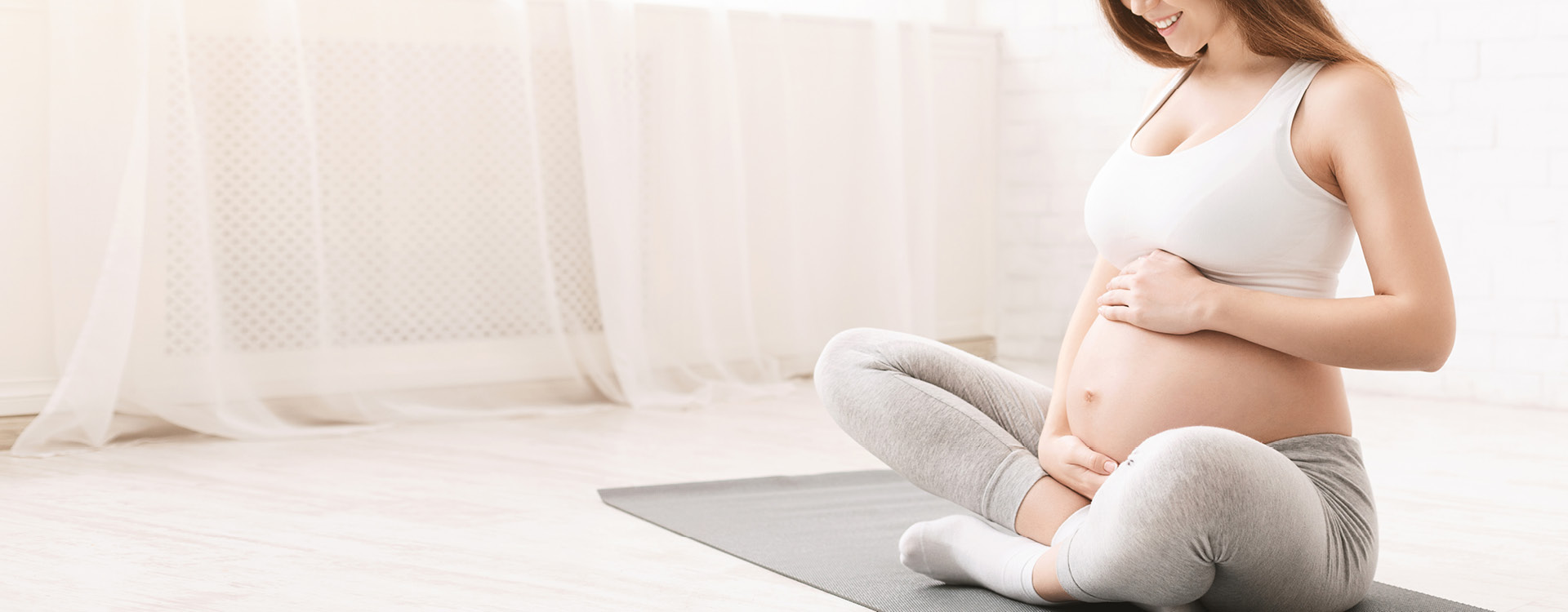With the excitement of pregnancy comes some unexpected aches, like round ligament pain.
If you’re curious about what this pain is, why it happens, or how to ease it, you’re in the right place.
Let’s explore everything you need to know about round ligament pain during pregnancy, so you can stay comfortable and focus on the joy of your journey.
What Is Round Ligament Pain?
Round ligament pain is a common pregnancy-related discomfort characterized by a sharp or aching pain in the lower abdomen or groin area. It occurs as the round ligaments, which support the uterus, stretch and thicken to accommodate the growing baby. This pain is generally harmless and is a normal part of pregnancy, but it can be uncomfortable.
The round ligaments are cord-like structures that run from the front of the uterus to the groin, helping to stabilize the uterus as it grows. During pregnancy, these ligaments can become strained, especially as the uterus rapidly expands. As the ligaments stretch, they may contract suddenly, causing a quick, sharp pain that many women describe as feeling like a muscle spasm or cramp.
While round ligament pain is a typical pregnancy symptom, it’s important to differentiate it from other types of pain that may signal a more serious issue. Understanding what round ligament pain feels like and when it typically occurs can help you manage the discomfort and recognize when it’s time to seek medical advice [*].
What Does Round Ligament Pain Feel Like?
Round ligament pain typically feels like a sudden, sharp, or jabbing sensation on one or both sides of the lower abdomen. This pain may be more noticeable when you make quick movements, such as standing up too quickly, rolling over in bed, or coughing. Some women also describe it as a dull ache that can linger after the initial sharp pain subsides [*].
The pain is usually brief, lasting only a few seconds to a minute, but it can be intense enough to stop you in your tracks. It often starts on one side of the abdomen and may radiate down to the groin or hip area. For some women, the pain may be more pronounced on one side of the body than the other, depending on the position of the baby and the specific ligaments being stretched.
It's also worth noting that round ligament pain can vary in intensity and frequency from one pregnancy to another. Some women may experience it more frequently during their second or third pregnancies, as the ligaments may be more stretched and less elastic than during their first pregnancy.
When Does Round Ligament Pain Start?
Round ligament pain usually begins in the second trimester, around 14 to 16 weeks into pregnancy [*]. This is the stage when the uterus starts to expand rapidly, putting more strain on the ligaments that support it. However, some women may start to experience round ligament pain earlier, especially if they are carrying multiple babies or if the uterus is expanding more quickly than usual.
In the first trimester, you may not notice round ligament pain as much, but as your baby grows and your uterus begins to rise out of the pelvis, the ligaments are stretched more significantly, leading to the characteristic pain. The onset of round ligament pain can catch some women off guard, especially if they haven’t experienced it in a previous pregnancy.
As your pregnancy progresses, the frequency and intensity of round ligament pain may increase, particularly during periods of rapid growth for the baby. The pain often peaks in the late second trimester and early third trimester when the baby and uterus are growing most quickly.
How Long Does Round Ligament Pain Last?
The duration of round ligament pain can vary widely from one woman to another [*]. For some, it may be a brief, fleeting discomfort that comes and goes throughout the day. For others, it may persist for longer periods, especially during activities that put additional strain on the ligaments, such as exercise or prolonged standing.
While round ligament pain is most common in the second trimester, it can continue into the third trimester for some women. The pain typically decreases in intensity as the body adjusts to the changes in the uterus, but it may not completely disappear until after the baby is born.
It's also possible for round ligament pain to become more pronounced during certain times of the day or in specific situations. For example, you may notice that the pain is worse in the evening after a long day of activity, or when you wake up in the morning after lying in a certain position all night [*].
What Causes Round Ligament Pain?
Round ligament pain is caused by the stretching and tightening of the round ligaments that support the uterus [*]. As your baby grows and your uterus expands, these ligaments have to stretch to accommodate the changes, which can cause pain. Several factors can contribute to round ligament pain, including:
- Uterine Growth: As the uterus expands to make room for the growing baby, the round ligaments are stretched and pulled, leading to discomfort. The rapid growth of the uterus during the second trimester puts extra strain on the ligaments, which are not accustomed to such stretching. This stretching is necessary to support the growing uterus and to help maintain its position within the abdomen, but it can also be a source of pain.
- Sudden Movements: Quick or jerky movements can cause the round ligaments to tighten abruptly, resulting in sharp pain. Actions like standing up quickly, sneezing, or coughing can cause the ligaments to contract suddenly, leading to a sudden, sharp sensation that can be quite uncomfortable. The pain from sudden movements is typically short-lived, but it can be intense enough to cause a momentary pause in activity.
- Physical Activity: Increased physical activity or certain exercises can put additional strain on the ligaments, exacerbating the pain. Activities that involve twisting or stretching the abdomen, such as yoga or certain types of exercise, can cause the ligaments to stretch further than usual, leading to discomfort. While staying active during pregnancy is important for overall health, it's also important to be mindful of activities that may trigger round ligament pain.
- Hormonal Changes: Hormonal changes during pregnancy can also play a role in round ligament pain. The hormone relaxin, which helps to loosen the ligaments and joints in preparation for childbirth, can cause the round ligaments to become more flexible and prone to stretching [*]. This increased flexibility can make the ligaments more susceptible to strain and pain, especially during periods of rapid growth or physical activity.
How to Relieve Round Ligament Pain
While round ligament pain is a normal part of pregnancy, there are several ways to alleviate the discomfort:
- Maternity Support Belt: Wearing a maternity support belt can help take some of the weight off your abdomen, reducing the strain on your ligaments. These belts are designed to provide gentle compression and support to the lower abdomen, which can help alleviate round ligament pain and improve overall comfort during pregnancy [*]. Be sure to choose a belt that fits properly and provides adequate support without being too tight.
- Gentle Movement: Moving slowly and avoiding sudden movements can help prevent the ligaments from tightening too quickly. When changing positions, do so gradually to minimize strain. For example, when getting out of bed, roll to your side and use your arms to push yourself up slowly, rather than sitting up quickly.
- Prenatal Yoga: Engaging in prenatal yoga or gentle stretching exercises can help improve flexibility and reduce the likelihood of round ligament pain. Focus on exercises that strengthen the core and pelvic muscles, as these can provide additional support to the ligaments. Yoga poses that involve gentle stretching and relaxation, such as the cat-cow pose or child's pose, can be particularly beneficial [*].
- Warm Compress: Applying a warm compress or taking a warm bath can relax the ligaments and soothe the pain. Just make sure the water is not too hot, as excessive heat can be harmful during pregnancy. A heating pad set to a low temperature can also be used to provide relief to the affected area, but be sure not to apply heat directly to the abdomen for prolonged periods [*].
- Proper Posture: Maintaining good posture, especially when sitting or standing, can reduce pressure on the ligaments and ease discomfort. Use a pillow to support your back when sitting, and avoid slouching or leaning to one side. When standing, keep your feet shoulder-width apart and avoid locking your knees, as this can increase pressure on the ligaments.
- Rest and Relaxation: Sometimes, the best way to relieve round ligament pain is simply to rest. If you’re experiencing discomfort, try lying down on your side with a pillow between your knees to take the pressure off your abdomen. Taking short breaks throughout the day to rest and relax can also help prevent the pain from becoming more intense.
Round Ligament Pain Prevention
While it may not be entirely possible to prevent round ligament pain, these tips can help minimize your chances of experiencing it:
- Stay Active: Regular, moderate exercise can help keep your muscles strong and flexible, which may reduce the likelihood of ligament pain. Consider activities like walking, swimming, or prenatal yoga, which are low-impact and gentle on the body. Staying active can also help improve circulation and reduce the risk of other pregnancy-related discomforts, such as back pain or swelling [*].
- Practice Good Posture: Being mindful of your posture can prevent unnecessary strain on your ligaments. When standing, keep your back straight and your shoulders relaxed. When sitting, use proper support to keep your spine aligned. Avoid crossing your legs or sitting in positions that put additional pressure on your abdomen.
- Avoid Heavy Lifting: Lifting heavy objects can put extra strain on your ligaments and increase your risk of pain. If you need to lift something, do so carefully and avoid twisting your body. Instead, bend your knees and use your legs to lift, keeping the object close to your body. If possible, ask for help with lifting heavy items to reduce the risk of injury.
- Listen to Your Body: Pay attention to your body and take note of activities or movements that seem to trigger round ligament pain. If you notice that certain exercises or activities cause discomfort, try to modify them or avoid them altogether. It's also important to take breaks when needed and to rest if you start to feel fatigued or uncomfortable.
- Stay Hydrated: Staying hydrated is essential for overall health during pregnancy, and it may also help prevent round ligament pain. Dehydration can cause muscle cramps and tension, which can exacerbate ligament pain. Aim to drink plenty of water throughout the day, and consider carrying a water bottle with you to stay hydrated on the go.
When to Call the Doctor
While round ligament pain is generally harmless, it’s important to know when to seek medical advice. Contact your doctor if you experience:
- Severe or persistent pain that doesn’t go away with rest.
- Pain accompanied by fever, chills, or nausea.
- Vaginal bleeding or spotting.
- Pain that occurs in regular intervals, which could indicate contractions.
- Difficulty walking or severe discomfort.
It's also important to contact your doctor if you experience any other symptoms that are concerning or unusual, such as dizziness, shortness of breath, or changes in fetal movement.
While round ligament pain is a common pregnancy symptom, it's always better to err on the side of caution and seek medical advice if you're unsure about your symptoms.
Round Ligament Pain FAQ
Where is round ligament pain located?
Round ligament pain is typically felt in the lower abdomen, on one or both sides, near the groin area.
At what stage of pregnancy does round ligament pain start?
It usually begins in the second trimester, around 14 to 16 weeks.
Does round ligament pain feel like cramps?
Round ligament pain can feel similar to cramps, but it is often sharper and more localized.
Can round ligament pain be constant?
It’s usually brief and triggered by sudden movements, but some women may experience more consistent discomfort.
Can round ligament pain last all day?
It can vary, but it’s more common for the pain to come and go rather than last all day.
How to tell the difference between round ligament pain and contractions?
Round ligament pain is usually sharp and sudden, often triggered by movement, while contractions tend to be rhythmic and gradually increase in intensity.
Does round ligament pain mean the baby is growing?
Yes, the pain is a sign that your body is adjusting to accommodate your growing baby.
Should I go to the ER for round ligament pain?
Generally, no. However, if you have severe pain or other concerning symptoms, it’s best to consult your doctor.
The Bottom Line
Round ligament pain is a common and normal part of pregnancy, though it can be uncomfortable. Understanding what causes it and how to manage the pain can help you stay comfortable and focus on the excitement of your pregnancy.
Remember that every pregnancy is different, and what works for one woman may not work for another. If you ever have concerns about your symptoms, don’t hesitate to reach out to your healthcare provider for guidance.
About MiracleCord
MiracleCord helps keep families safe by banking their infant’s umbilical cord blood and tissue stem cells. More than 80 diseases and conditions have been FDA-approved for treatment using cord blood stem cells,, and greater than 6,800 clinical trials have been initiated exploring new therapies.
Discover why Global Health & Pharma rated MiracleCord the #1 U.S. Cord Blood Bank by downloading our Free Info Kit.
While round ligament pain can be a hassle, working with MiracleCord is a breeze. Secure your baby’s future with ease while you focus on the excitement of your pregnancy.
DISCLAIMER: THE INFORMATION ON THIS WEBSITE IS NOT INTENDED TO BE USED AS MEDICAL ADVICE.The materials and information contained on the MiracleCord website is provided for educational and informational purposes only, and is not intended to, and does not constitute, medical or other health advice or diagnosis, and should not be used as such. You should not use this information to diagnose or treat a health problem or disease. If you are seeking personal medical advice, you should consult with a licensed physician. Always consult with a qualified health care provider regarding a medical condition.




